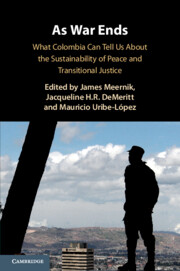Book contents
- As War Ends
- As War Ends
- Copyright page
- Contents
- Contributors
- Acknowledgments
- Introduction
- 1 The Complexity of the Organizational Design for Implementation of a Peace Accord
- 2 Violence, Grassroots Pressure, and Civil War Peace Processes
- 3 Land, Violence, and the Colombian Peace Process
- 4 Determinants of State Strength and Capacity
- 5 The Threat of Organized Crime in Post-Conflict Colombia
- 6 Violence after Peace
- 7 Two Emblematic Peacebuilding Initiatives in Antioquia
- 8 From Counterinsurgency to Peacebuilding
- 9 Transitional Justice in the Colombian Final Accord
- 10 The Comprehensive System of Truth, Justice, Reparation, and Non-Repetition
- 11 Una Tierra Inexplorada
- 12 Leading the Public to Peace
- 13 Securing the Peace and Promoting Human Rights in Post-Accord Colombia
- 14 Achieving an Unpopular Balance
- 15 Countering Violent Extremism through Narrative Intervention
- 16 Geographies of Truth in the Colombian Transitional Justice Process
- 17 Conclusion
- Index
- References
16 - Geographies of Truth in the Colombian Transitional Justice Process
Published online by Cambridge University Press: 18 July 2019
- As War Ends
- As War Ends
- Copyright page
- Contents
- Contributors
- Acknowledgments
- Introduction
- 1 The Complexity of the Organizational Design for Implementation of a Peace Accord
- 2 Violence, Grassroots Pressure, and Civil War Peace Processes
- 3 Land, Violence, and the Colombian Peace Process
- 4 Determinants of State Strength and Capacity
- 5 The Threat of Organized Crime in Post-Conflict Colombia
- 6 Violence after Peace
- 7 Two Emblematic Peacebuilding Initiatives in Antioquia
- 8 From Counterinsurgency to Peacebuilding
- 9 Transitional Justice in the Colombian Final Accord
- 10 The Comprehensive System of Truth, Justice, Reparation, and Non-Repetition
- 11 Una Tierra Inexplorada
- 12 Leading the Public to Peace
- 13 Securing the Peace and Promoting Human Rights in Post-Accord Colombia
- 14 Achieving an Unpopular Balance
- 15 Countering Violent Extremism through Narrative Intervention
- 16 Geographies of Truth in the Colombian Transitional Justice Process
- 17 Conclusion
- Index
- References
Summary
The last chapter of this volume is somewhat unusual for an edited book in social science research on peace and transitional justice. But, it is one that we thought it was important to include. “Geographies of Truth,” by personnel from the Casa de la Memoria (House of Memory) of Medellin, is a discussion of how individuals from the museum developed key exhibits on the violence in Colombia. This process begins with a great many similarities to social science projects as literature is reviewed, original data are collected, and all the materials are analyzed for their relevance and role in, in this case, museum exhibits. At this stage, scholars would typically then conceive of our understanding and representation of events of the past in fairly conventional, analytical products that are designed to communicate to fellow academics. But those who curate museums like Casa de la Memoria must arrive at a work product in ways that will affect people not just intellectually but also emotionally and physically through the various senses. Such exhibits are also constructed for a much larger audience − the people of the nation − whose experiences are being represented. Thus, the process by which these exhibits are created is both fascinating as both an alternative means of conveying understandings about war and violence, and for the responsibilities the museum personnel have toward society as a whole in representing their truths. There is much we, as peace studies scholars, can gain from understanding their work.
- Type
- Chapter
- Information
- As War EndsWhat Colombia Can Tell Us About the Sustainability of Peace and Transitional Justice, pp. 366 - 391Publisher: Cambridge University PressPrint publication year: 2019
References
- 1
- Cited by



